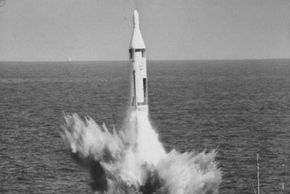Nuclear Submarines in the Cold War
Nuclear submarines weren't developed exclusively for use in the Cold War. Nuclear submarines came about as a result of technological advances; their use after creation, however, was a result of the Cold War.
At the time of the Manhattan Project (before the Cold War really began), there was some talk about the possibility of using nuclear power to propel submarines. The idea of arming submarines with nuclear missiles didn't come up until the 1960 launching of the George Washington. When nuclear energy was conceived of as a power source for submarines, that was a jaw-dropper in itself. But when navies gained the ability to launch a nuclear warhead from a nuclear-powered submarine, the world had touched on what was quite arguably the most powerful -- in terms of strength and mobility -- weapons system ever.
Advertisement
During the Cold War, the U.S. Navy developed two different types of nuclear-powered submarines. The first was a sub that could launch nuclear missiles at other nations, called a Fleet Ballistic Missile Submarine, also known as an SSBN or "boomer." The other was an Attack Submarine, signified as SSN, or "fast attack." SSBNs are the larger of the two, up to around 560 feet (170 m) in length, while SSNs are built with speed and stealth in mind, and are around 360 feet (109 m) in length.
Nuclear submarines served three primary roles during the Cold War: They performed strategic deterrence patrols, hunted other submarines and carried out special operations.
- Strategic deterrence patrols - SSBNs, or "boomers," played an important role in the United States' nuclear strategic posture. The presence of nuclear missiles in constantly changing locations and depths made these submarines practically insurmountable as a nuclear deterrent. This helped maintain the Cold War equilibrium of Mutual Assured Destruction because it was simply impossible for either side to neutralize its opponent's airborne, land-based and underwater nuclear assets.
- Hunting submarines - The Navy's submarine force was equipped to track, hunt and -- if necessary -- destroy enemy submarines. To do this, the Navy armed its SSNs ("fast attacks") with anti-sub mines and torpedoes. These subs did (and still do) make up the majority of the nuclear submarine fleet.
- Special operations - The incredible range and speed of nuclear submarines make them prime candidates to transport special operations teams, such as Navy SEAL teams, into and out of enemy territory. The subs are also ideal for covertly spying on foreign missile tests, fleet maneuvers, naval war games and coastal activity. In recent years, the Navy has introduced a new class of submarine, the Guided Missile Submarine (SSGN), that's armed with cruise missiles and is configured to serve the purposes of U.S. covert special-forces operations. Because navies must frequently take part in war games and other naval exercises, nuclear subs provide the perfect perch from which to observe. Additionally, any suspicious movement of material or personnel in and out of other nations' ports can be detected by a nuclear submarine.
At least six nations now operate nuclear submarines: the U.S., Russia, India, France, China and the U.K. Several other nations, such as Brazil and Pakistan, are interested or actively attempting to develop (or purchase) nuclear-submarine capabilities. Nuclear submarines offer these nations a bit of prestige, not to mention enhanced offensive and defensive capabilities. As more nations seek to acquire this technology, navies must decide how to reconfigure their fleets (for more on this, read "Do we still need nuclear submarines?")
In the next section, we'll learn about the different parts and sections of a nuclear submarine.
